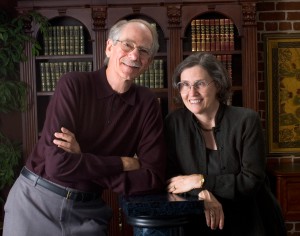Humanist Teacher Spotlight: Mynga Futrell and Paul Geisert

Mynga Futrell has been an educator at all levels from elementary school through the university. She has a Ph.D. in Curriculum and Instruction with a specialization in Science Education. Paul Geisert, Mynga’s husband, has been a high school biology teacher and a professor of Zoology and holds a Ph. D. in Instructional Systems.
In 2003 they established the Brights movement with the intent of creating an Internet constituency that promotes public understanding and acknowledgment of the naturalistic worldview, which is free of supernatural and mystic elements; gains public recognition that persons who hold such a worldview can bring principled actions to bear on matters of civic importance; and educates society toward accepting the full and equitable civic participation of all such individuals.
When one thinks of Mynga and Paul, their work with OABITAR (Objectivity, Accuracy, and Balance In Teaching About Religion) toward improving public school teaching about religion immediately comes to mind.
OABITAR, whose goal is promoting academic integrity and a constitutionally sound position of religious neutrality in public education, supported both their development of the Teaching About Religion in Support of Civic Pluralism website (www.worldvieweducation.org) and an instructional module for grades 6-12, “Different Drummers: Nonconforming Thinkers in History.” This latter resource contains 300+ pages of classroom-tested materials that aid teachers in including both religious and non-religious worldviews when teaching about religion in history and/or social studies. The lessons and activities foster academic neutrality regarding religion and non-religion, nurture civic pluralism, and counter religious intolerance.
OABITAR has developed guidelines on “What Makes Sense in the Public Schools.” While the main points are listed below, it also provides all too common counterparts (practices that do not make sense):
THIS MAKES SENSE: Teaching about religion, giving due academic consideration to beliefs and practices; the role of religion in history and contemporary society, and religious themes in music, art, and literature.
THIS MAKES SENSE: Conducting studies about religion in a neutral and academic way that cannot be interpreted as approximating or simulating religious activity.
THIS MAKES SENSE: Ensuring that the overall program regarding religion reflects a spirit of civic inclusiveness apropos to a democratic and pluralistic society (by teaching about religion with a view to diversity that is conducive to promoting civic harmony).
THIS MAKES SENSE: Teaching secular values such as honesty, respect for others, courage, kindness, and good citizenship.
THIS MAKES SENSE: Voicing with students your endorsement of shared civic values such as honesty, respect for others, courage, kindness, and good citizenship.
THIS MAKES SENSE: Considering, in an academic and age-appropriate manner, varied religious and nonreligious (freethought) influences on art, on music, on literature, and on social studies.
THIS MAKES SENSE: Employing music, art, literature, and drama material having religious themes as long as the material relates to sound, secular educational goals and is presented to students in an academic and impartial manner.
THIS MAKES SENSE: Allowing students to express their own religious and nonreligious views, as long as such expression is relevant to the classroom discussion at hand.
THIS MAKES SENSE: Evaluating home and classroom work by ordinary academic standards of substance and relevance, and against legitimate pedagogical concerns.
THIS MAKES SENSE: Teaching about the revered scriptures of any religion as literature, or about the historic influences of such scriptures within a culture, if the lesson is secular, religiously neutral and objective.
THIS MAKES SENSE: Using attribution strategies (e.g., you use such phrases as “According to the Hebrew scriptures …” or “Many Sikhs believe …”) to safeguard against instilling your personal religious or non-religious beliefs.
THIS MAKES SENSE: Referring in class to concepts stated within religious documents or texts in a dispassionate “third party” manner. For example, “Adherents of ___ believe that these statements are true.” Or, “____ [the religion] maintains that ….”
THIS MAKES SENSE: Judging ancient writings using academically sound procedures rather than the standards of a given religion or the predominant community outlook.
THIS MAKES SENSE: Including in your planning for a wide variety of stories to be read by students, tales drawn from various faiths (as long as the selected material is presented as part of a secular program of study).
THIS MAKES SENSE: Inviting a guest speaker to augment classroom instruction and provide students a more comprehensive understanding of the tradition or worldview under study.
THIS MAKES SENSE: Using holiday themes in the context of a broader program of studies based objectively on their academic value.
Thank you to Mynga Futrell and Paul Geisert, who always make a great deal of sense in describing teaching about religion objectively, accurately and balanced.
Bob Bhaerman, Ed.D., is the director of the Kochhar Humanist Education Center of the American Humanist Association.
